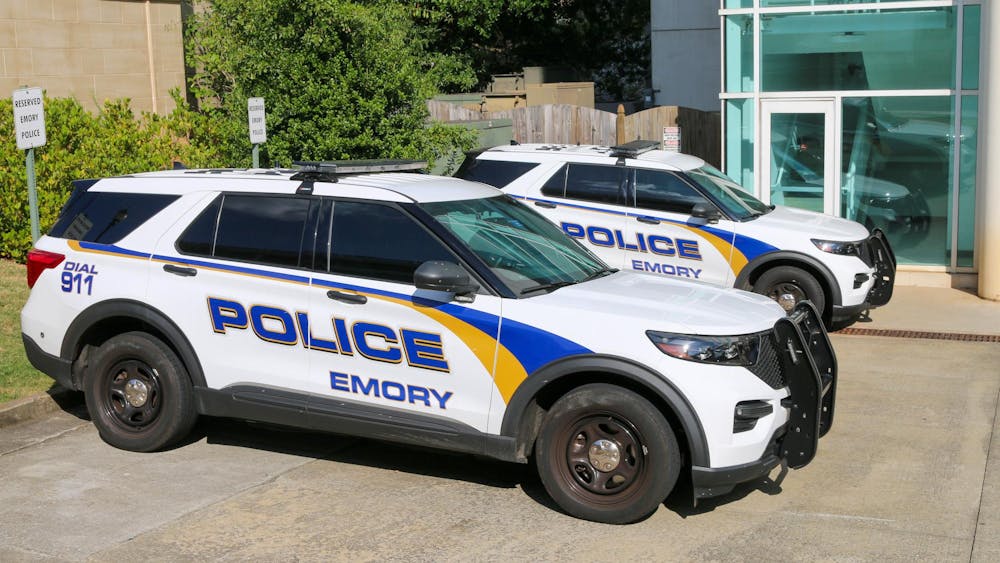
Michael C. Carlos Hall is usually quiet, but a host of voices echoed through the building on Feb. 16 and 17 as it became the set of “Love and Information” (2012), an immersive theater production by Dooley’s Players. In the play, British playwright Caryl Churchill presents a series of short scenes in which people grapple with issues of knowledge, communication and love.
A crowd gathered in the entryway while audience members waited with excitement for the opening performance. Directors Zack Gunter (24C) and Hailey Sipes (24C) stood at the base of the broad spiral staircase, half-concealed by the white stone body of a lunging statue. The air was full of energy not yet translated into movement and the excitement of an audience unsure what exactly to expect.
Before the performance began, Gunter explained what was about to unfold. The scenes of “Love and Information” would play out simultaneously as actors moved throughout Carlos Hall. The audience would assume an active role, tracking the actors as they roamed the building, deciding which voices to follow and which stories to pursue. Sacrifices were unavoidable: An audience member could not see everything.
The tall glass doors of Carlos Hall swung open and the cast streamed in from the Quadrangle. Student actors Emi Fernandez (24C), Kelly Fox (24C), Emma Friese (24C), Carl Kash (27C), Andreanna Kitas (26C), Emory MacLaughlin (24C), Josie Maier (24C), Gabriel Nascimento Silva, Kian Sheridan (27C), Chaya Tong (25C) and Nora Xu (25C) formed a neat line. They split the crowd, slipped by the heel of the looming statue and ascended to form a crescent along the stairs. The actors introduced themselves as A, B, C and so on through the alphabet until the letter K. Their costumes were simple, everyday clothing. In the scenes to follow, the cast would take on various relations to one another. They were “eleven somebodies wandering around, searching for connection,” Gunter noted in the event’s program. The actors dispersed, and after a moment, Gunter invited the audience to follow them.
The next hour felt part scavenger hunt, part theater experience and part dream. Down one flight from the lobby, two girls quizzed each other on an actor’s birthdate and his favorite things until suddenly, they both failed: Neither knew the man’s favorite smell. The girls panicked and tore apart the magazine in their hands.
Later, a tense discussion played out in the building’s tight faculty kitchen. Audience members peered through the door to catch references to an old friend, a grave mistake and a connection in the police force. For each scene, the audience had to eavesdrop and spy; they became “voyeurs,” as Gunter and Sipes wrote in the program.
Between vignettes, the cast members traversed Carlos Hall. They weaved through the wandering audience with thoughtful, unreadable expressions. In a quiet hallway, one actor held his head in his hands while another rubbed his back in comfort.
A family sat and watched a wedding video, laughing as they told stories until the conversation came around to memory. They discussed what was never documented and what couldn’t be remembered: Their grandparents’ wedding, their great grandparents’ and the existence of Neanderthals. A now-former employee screamed at her boss who fired her over email. A couple took their child to the doctor who told them their child had a rash. Two players went back and forth speaking in DNA code, translating each other’s A’s to T’s and C’s to G’s. At the top of the staircase, another pair clasped hands. One swore their love to the other, who responded by labeling them a stranger.Three actors sat in a row as if in a waiting room, asking again and again if the others had seen their car keys. In the lobby, a girl told her companion that she was not really her sister but her mother. Throughout all of it, something else was happening somewhere else in the building. Upstairs, a woman smoked while audience members matched her silence. Downstairs, actors howled and screamed.
This is what made the performance feel surreal: Out of a moment of calm, any kind of human experience could erupt. At times, the scenes felt just out of reach, as if some unattainable context or logic existed that, if revealed, would snap each vignette into sharp focus. As Sipes noted in the event’s program, the play explores the possession — and the loss — of both knowledge and love.
“Love and Information” called the variables of clarity, time and space into question. Even ducking into the bathroom reveals a scene in progress: Two actors cry and embrace. They smooth each other’s hair as an audience member washes their hands at the next sink. This is what made the performance uncanny, just barely removed from the normal. Even as the actors gave striking performances, they moved among the audience. They are just people, and the scenes are just moments in their lives. There is no separation.
Eventually, somehow, everyone returned to the lobby. The actors had led the audience members back in time to witness a final ritual. First, they performed acts of obedience like sit, stay and fetch. Next, the players took on animal forms; one actor’s arms became writhing snakes as another prowled the floor. Their erratic movement crescendoed in a frenzy that ended with one actor’s body still on the floor. In the silence that followed, the players moved through the front door into the dark. Most of them hurried down the steps, but Friese, who was last through the door, moved with slow intentionality. The silence held until each actor passed out of view, then the audience broke into applause.









